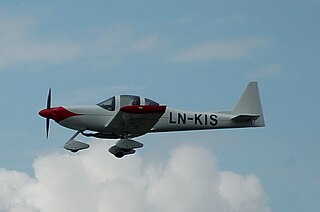Related Research Articles
The Fisher Youngster is a Canadian single-seat, conventional landing gear, single-engined, biplane kit aircraft designed for construction by amateur builders. The aircraft was inspired by the German Bücker Bü 133 Jungmeister aerobatic aircraft of the 1930s.

The Murphy JDM-8 is a Canadian single-seat ultralight monoplane designed by Daryl Murphy. The type was intended to be sold as a kit for home construction by Murphy Aircraft of Chilliwack, British Columbia.

The Aero-Service Puma is a Polish ultralight aircraft, designed and produced by Aero-Service Jacek Skopiński of Warsaw. The aircraft is supplied complete and ready-to-fly.

The Murphy Elite is a Canadian light aircraft that was designed and is produced by Murphy Aircraft of Chilliwack, British Columbia. The aircraft is supplied as a kit for amateur construction.
The Pro-Composites Vision is an American amateur-built aircraft, designed by Steve Rahm and produced by Pro-Composites of Buffalo Grove, Illinois. The aircraft is supplied in the form of plans for amateur construction, with some pre-formed parts made available to speed construction.

The St-Just Cyclone, also called the St-Just Cyclone 180, is a Canadian homebuilt aircraft that was designed and produced by St-Just Aviation of Mirabel, Quebec. The company has since moved to Boucherville, Quebec. While it was available the aircraft was supplied as a kit and in the form of plans for amateur construction.

The Viking SF-2A Cygnet, also called the Sisler SF-2A Cygnet and the HAPI SF-2A Cygnet, is an American STOL amateur-built aircraft, designed by Bert Sisler and produced by Viking Aircraft LLC. The aircraft is supplied in the form of plans for amateur construction. The Cygnet first flew in 1973.
The Bagalini Bagalini is an Italian homebuilt ultralight aircraft that was designed by Marino Bagalini. The aircraft is supplied in the form of plans for amateur construction.
The Bagalini Baganfibio is an Italian homebuilt flying boat that was designed by Marino Bagalini. The aircraft is supplied in the form of plans for amateur construction.

The Collins Dipper was an American homebuilt flying boat that was designed and produced by Collins Aero of Chadds Ford, Pennsylvania and first flown in 1982. The aircraft was supplied in the form of plans for amateur construction. Only one was built and none remain registered.
The Historical PZL P.11c is an American homebuilt aircraft that was designed and produced by Historical Aircraft Corporation of Nucla, Colorado. The aircraft is a 66% scale replica of the Polish PZL P.11c fighter and when it was available was supplied as a kit for amateur construction.

The Lancair Tigress was an American homebuilt aircraft that was designed by Lance Neibauer and intended for production by Lancair of Redmond, Oregon. Introduced in mid-late 1990s, it was essentially a Lancair IV with a much more powerful engine. When the engine was cancelled just as it was entering production, the Tigress project ended with it. Only prototypes were produced.

The Baker Bobcat and the follow-on Baker Supercat are American homebuilt aircraft that were designed by Bobby Baker.

The Storm 300 is an Italian homebuilt aircraft that was designed and produced by Storm Aircraft of Sabaudia. Storm Aircraft was originally called SG Aviation srl. When it was available the aircraft was supplied as a kit for amateur construction.
The Sea Storm is an Italian homebuilt amphibious flying boat that was designed and produced by Storm Aircraft of Sabaudia. Storm Aircraft was originally called SG Aviation srl. When it was available the aircraft was supplied as a kit for amateur construction.
The Storm 320E, sometimes written Storm 320 E, is an Italian microlight aircraft that was designed and produced by Storm Aircraft of Sabaudia. Storm Aircraft was originally called SG Aviation srl. When it was available the aircraft was supplied as a kit for amateur construction.
The Starfire Firebolt, sometimes called the Starfire Firebolt Convertible, due to its removable canopy, is an American homebuilt aerobatic biplane that was designed by G. H. "Mac" McKenzie and produced by Starfire Aviation of Tempe, Arizona. When it was available the aircraft was supplied in the form of plans for amateur construction, with some pre-fabricated parts available.

The Tri-R KIS TR-1 is an American homebuilt aircraft that was designed by Rich Trickel and produced by Tri-R Technologies of Oxnard, California, introduced in the 1990s. When it was available the aircraft was supplied as a kit for amateur construction.
The Coelho AC-11 is a Brazilian homebuilt aircraft that was designed and produced by Altair Coelho of Eldorado do Sul and introduced in 1994. The aircraft was intended to be supplied as a kit for amateur construction, but only one was completed.

The TeST TST-5 Variant is a Czech homebuilt aircraft that was designed and produced by TeST Gliders of Brno, introduced c. 1998. When it was available the aircraft was supplied as a completely assembled aircraft, without engine or instruments, and also as a kit for amateur construction.
References
- 1 2 3 4 5 6 7 8 Purdy, Don: AeroCrafter - Homebuilt Aircraft Sourcebook, Fifth Edition, page 344. BAI Communications, 15 July 1998. ISBN 0-9636409-4-1
- 1 2 3 "American Homebuilts John Doe". all-aero.com. Retrieved April 15, 2015.
- 1 2 3 4 Jones, Mary (November 22, 1994). "Investigating the John Doe". EAA Experimenter. Archived from the original on May 17, 2006. Retrieved April 15, 2015.
- 1 2 3 Downey, Julia: 2008 Kit Aircraft Directory, Kitplanes, Volume 24, Number 12, December 2007, page 42. Primedia Publications. ISSN 0891-1851
- ↑ Federal Aviation Administration (April 15, 2015). "Make / Model Inquiry Results" . Retrieved April 15, 2015.